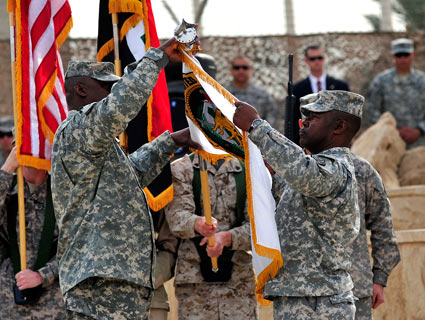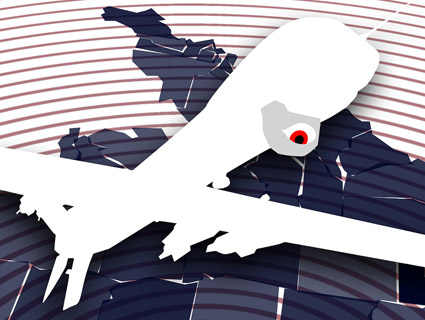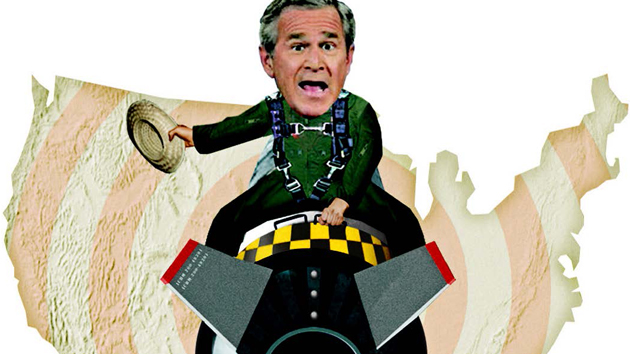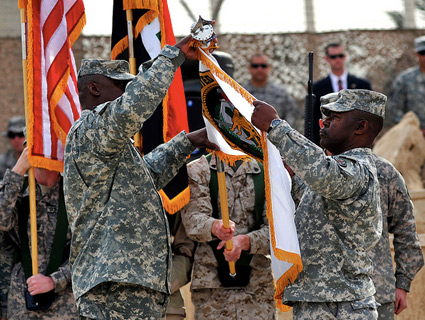
US soldiers at the flag casing ceremony that marked the end of Operation New Dawn, at the former Sather Air Base, in Baghdad, Iraq, on Dec. 15, 2011.<a href="http://www.flickr.com/photos/soldiersmediacenter/6516088807/">US Army</a>/Flickr
This story first appeared on the TomDispatch website.
It was to be the war that would establish empire as an American fact. It would result in a thousand-year Pax Americana. It was to be “mission accomplished” all the way. And then, of course, it wasn’t. And then, almost nine dismal years later, it was over (sorta).
It was the Iraq War, and we were the uninvited guests who didn’t want to go home. To the last second, despite President Obama’s repeated promise that all American troops were leaving, despite an agreement the Iraqi government had signed with George W. Bush’s administration in 2008, America’s military commanders continued to lobby and Washington continued to negotiate for 10,000 to 20,000 US troops to remain in-country as advisors and trainers.
![]() Only when the Iraqis simply refused to guarantee those troops immunity from local law did the last Americans begin to cross the border into Kuwait. It was only then that our top officials began to hail the thing they had never wanted, the end of the American military presence in Iraq, as marking an era of “accomplishment.” They also began praising their own “decision” to leave as a triumph, and proclaimed that the troops were departing with—as the president put it—”their heads held high.”
Only when the Iraqis simply refused to guarantee those troops immunity from local law did the last Americans begin to cross the border into Kuwait. It was only then that our top officials began to hail the thing they had never wanted, the end of the American military presence in Iraq, as marking an era of “accomplishment.” They also began praising their own “decision” to leave as a triumph, and proclaimed that the troops were departing with—as the president put it—”their heads held high.”
In a final flag-lowering ceremony in Baghdad, clearly meant for US domestic consumption and well attended by the American press corps but not by Iraqi officials or the local media, Secretary of Defense Leon Panetta spoke glowingly of having achieved “ultimate success.” He assured the departing troops that they had been a “driving force for remarkable progress” and that they could proudly leave the country “secure in knowing that your sacrifice has helped the Iraqi people begin a new chapter in history, free from tyranny and full of hope for prosperity and peace.” Later on his trip to the Middle East, speaking of the human cost of the war, he added, “I think the price has been worth it.”
And then the last of those troops really did “come home”—if you define “home” broadly enough to include not just bases in the US but also garrisons in Kuwait, elsewhere in the Persian Gulf, and sooner or later in Afghanistan.
On December 14th at Fort Bragg, North Carolina, the president and his wife gave returning war veterans from the 82nd Airborne Division and other units a rousing welcome. With some in picturesque maroon berets, they picturesquely hooahed the man who had once called their war “dumb.” Undoubtedly looking toward his 2012 campaign, President Obama, too, now spoke stirringly of “success” in Iraq, of “gains,” of his pride in the troops, of the country’s “gratitude” to them, of the spectacular accomplishments achieved as well as the hard times endured by “the finest fighting force in the history of the world,” and of the sacrifices made by our “wounded warriors” and “fallen heroes.”
He praised “an extraordinary achievement nine years in the making,” framing their departure this way: “Indeed, everything that American troops have done in Iraq—all the fighting and all the dying, the bleeding and the building, and the training and the partnering—all of it has led to this moment of success… [W]e’re leaving behind a sovereign, stable and self-reliant Iraq, with a representative government that was elected by its people.”
And these themes—including the “gains” and the “successes,” as well as the pride and gratitude, which Americans were assumed to feel for the troops—were picked up by the media and various pundits. At the same time, other news reports were highlighting the possibility that Iraq was descending into a new sectarian hell, fueled by an American-built but largely Shiite military, in a land in which oil revenues barely exceeded the levels of the Saddam Hussein era, in a capital city which still had only a few hours of electricity a day, and that was promptly hit by a string of bombings and suicide attacks from an al-Qaeda affiliated group (nonexistent before the invasion of 2003), even as the influence of Iran grew and Washington quietly fretted.
A Consumer Society at War
It’s true that, if you were looking for low-rent victories in a near trillion-dollar war, this time, as various reporters and pundits pointed out, US diplomats weren’t rushing for the last helicopter off an embassy roof amid chaos and burning barrels of dollars. In other words, it wasn’t Vietnam and, as everyone knew, that was a defeat. In fact, as other articles pointed out, our—as no fitting word has been found for it, let’s go with—withdrawal was a magnificent feat of reverse engineering, worthy of a force that was a nonpareil on the planet.
Even the president mentioned it. After all, having seemingly moved much of the US to Iraq, leaving was no small thing. When the US military began stripping the 505 bases it had built there at the cost of unknown multibillions of taxpayer dollars, it sloughed off $580 million worth of no-longer-wanted equipment on the Iraqis. And yet it still managed to ship to Kuwait, other Persian Gulf garrisons, Afghanistan, and even small towns in the US more than two million items ranging from Kevlar armored vests to port-a-potties. We’re talking about the equivalent of 20,000 truckloads of materiel.
Not surprisingly, given the society it comes from, the US military fights a consumer-intensive style of war and so, in purely commercial terms, the leaving of Iraq was a withdrawal for the ages. Nor should we overlook the trophies the military took home with it, including a vast Pentagon database of thumbprints and retinal scans from approximately 10 percent of the Iraqi population. (A similar program is still underway in Afghanistan.)
When it came to “success,” Washington had a good deal more than that going for it. After all, it plans to maintain a Baghdad embassy so gigantic it puts the Saigon embassy of 1973 to shame. With a contingent of 16,000 to 18,000 people, including a force of perhaps 5,000 armed mercenaries (provided by private security contractors like Triple Canopy with its $1.5 billion State Department contract), the “mission” leaves any normal definition of “embassy” or “diplomacy” in the dust.
In 2012 alone, it is slated to spend $3.8 billion, a billion of that on a much criticized police-training program, only 12 percent of whose funds actually go to the Iraqi police. To be left behind in the “postwar era,” in other words, will be something new under the sun.
Still, set aside the euphemisms and the soaring rhetoric, and if you want a simple gauge of the depths of America’s debacle in the oil heartlands of the planet, consider just how the final unit of American troops left Iraq. According to Tim Arango and Michael Schmidt of the New York Times, they pulled out at 2:30 a.m. in the dead of night. No helicopters off rooftops, but 110 vehicles setting out in the dark from Contingency Operating Base Adder. The day before they left, according to the Times reporters, the unit’s interpreters were ordered to call local Iraqi officials and sheiks with whom the Americans had close relations and make future plans, as if everything would continue in the usual way in the week to come.
 In other words, the Iraqis were meant to wake up the morning after to find their foreign comrades gone, without so much as a goodbye. This is how much the last American unit trusted its closest local allies. After shock and awe, the taking of Baghdad, the mission-accomplished moment, and the capture, trial, and execution of Saddam Hussein, after Abu Ghraib and the bloodletting of the civil war, after the surge and the Sunni Awakening movement, after the purple fingers and the reconstruction funds gone awry, after all the killing and the dying, the US military slipped into the night without a word.
In other words, the Iraqis were meant to wake up the morning after to find their foreign comrades gone, without so much as a goodbye. This is how much the last American unit trusted its closest local allies. After shock and awe, the taking of Baghdad, the mission-accomplished moment, and the capture, trial, and execution of Saddam Hussein, after Abu Ghraib and the bloodletting of the civil war, after the surge and the Sunni Awakening movement, after the purple fingers and the reconstruction funds gone awry, after all the killing and the dying, the US military slipped into the night without a word.
If, however, you did happen to be looking for a word or two to capture the whole affair, something less polite than those presently circulating, “debacle” and “defeat” might fit the bill. The military of the self-proclaimed single greatest power of planet Earth, whose leaders once considered the occupation of the Middle East the key to future global policy and planned for a multi-generational garrisoning of Iraq, had been sent packing. That should have been considered little short of stunning.
Face what happened in Iraq directly and you know that you’re on a new planet.
Doubling Down on Debacle
Of course, Iraq was just one of our invasions-turned-counterinsurgencies-turned-disasters. The other, which started first and is still ongoing, may prove the greater debacle. Though less costly so far in both American lives and national treasure, it threatens to become the more decisive of the two defeats, even though the forces opposing the US military in Afghanistan remain an ill-armed, relatively weak set of minority insurgencies.
As great as was the feat of building the infrastructure for a military occupation and war in Iraq, and then equipping and supplying a massive military force there year after year, it was nothing compared to what the U.S had to do in Afghanistan. Someday, the decision to invade that country, occupy it, build more than 400 bases there, surge in an extra 60,000 or more troops, masses of contractors, CIA agents, diplomats, and other civilian officials, and then push a weak local government to grant Washington the right to remain more or less in perpetuity will be seen as the delusional actions of a Washington incapable of gauging the limits of its power in the world.
Talk about learning curves: having watched their country fail disastrously in a major war on the Asian mainland three decades earlier, America’s leaders somehow convinced themselves that nothing was beyond the military prowess of the “sole superpower.” So they sent more than 250,000 American troops (along with all those Burger Kings, Subways, and Cinnabons) into two land wars in Eurasia. The result has been another chapter in a history of American defeat—this time of a power that, despite its pretensions, was not only weaker than in the Vietnam era, but also far weaker than its leaders were capable of imagining.
You would think that, after a decade of watching this double debacle unfold, there might be a full-scale rush for the exits. And yet the drawdown of US “combat” troops in Afghanistan is not scheduled to be completed until December 31, 2014 (with thousands of advisors, trainers, and special operations forces slated to remain behind); the Obama administration is still negotiating feverishly with the government of Afghan President Hamid Karzai on an agreement that—whatever the euphemisms chosen—would leave Americans garrisoned there for years to come; and, as in Iraq in 2010 and 2011, American commanders are openly lobbying for an even slower withdrawal schedule.
Again as in Iraq, in the face of the obvious, the official word couldn’t be peachier. In mid-December, Secretary of Defense Leon Panetta actually told frontline American troops there that they were “winning” the war. Our commanders there similarly continue to tout “progress” and “gains,” as well as a weakening of the Taliban grip on the Pashtun heartland of southern Afghanistan, thanks to the flooding of the region with US surge troops and continual, devastating night raids by US special operations forces.
Nonetheless, the real story in Afghanistan remains grim for a squirming former superpower—as it has been ever since its occupation resuscitated the Taliban, the least popular popular movement imaginable. Typically, the U.N. has recently calculated that “security-related events” in the first 11 months of 2011 rose 21 percent over the same period in 2010 (something denied by NATO). Similarly, yet more resources are being poured into an endless effort to build and train Afghan security forces. Almost $12 billion went into the project in 2011 and a similar sum is slated for 2012, and yet those forces still can’t operate on their own, nor do they fight particularly effectively (though their Taliban opposites have few such problems).
Afghan police and soldiers continue to desert in droves and the US general in charge of the training operation suggested last year that, to have the slightest chance of success, it would need to be extended through at least 2016 or 2017. (Forget for a moment that an impoverished Afghan government will be utterly incapable of supporting or financing the forces being created for it.)
The Pashtun-based Taliban, like any classic guerrilla force, has faded away before the overwhelming military of a major power, yet it still clearly has significant control over the southern countryside, and in the last year its acts of violence have spread ever more deeply into the non-Pashtun north. And if US forces in Iraq didn’t trust their local partners at the moment of departure, Americans in Afghanistan have every reason to be far more nervous. Afghans in police or army uniforms—some trained by the Americans or NATO, some possibly Taliban guerrillas dressed in outfits bought on the black market—have regularly turned their guns on their putative allies in what’s referred to as “green-on-blue violence.” As 2011 ended, for instance, an Afghan army soldier shot and killed two French soldiers. Not long before, several NATO troops were wounded when a man in an Afghan army uniform opened fire on them.
In the meantime, US troop strength is starting to drop; NATO allies look unsteady indeed; and the Taliban, whatever its trials and tribulations, undoubtedly senses that time is on its side.
Depending on the Kindness of Strangers
Weak as the several outfits that make up the Taliban may be, there can be no question that they are preparing to successfully outlast the greatest military power of our time. And mind you, none of this does more than touch on the debacle that the Afghan War could become. If you want to judge the full folly of the American war (and gauge the waning of US power globally), don’t even bother to look at Afghanistan. Instead, check out the supply lines leading to it.
After all, Afghanistan is a landlocked country in Central Asia. The US is thousands of miles away. No giant ports-cum-bases as at Cam Ranh Bay in South Vietnam in the 1960s are available to bring in supplies. For Washington, if the guerrillas it opposes go to war with little more than the clothes on their backs, its military is another matter. From meals to body armor, building supplies to ammunition, it needs a massive—and massively expensive—supply system. It also guzzles fuel the way a drunk downs liquor and has spent more than $20 billion in Afghanistan and Iraq annually just on air conditioning.
To keep itself in good shape, it must rely on tortuous supply lines thousands of miles long. Because of this, it is not the arbiter of its own fate in Afghanistan, though this seems to have gone almost unnoticed for years.
Of all the impractical wars a declining empire could fight, the Afghan one may be the most impractical of all. Hand it to the Soviet Union, at least its “bleeding wound”—the phrase Soviet leader Mikhail Gorbachev gave to its Afghan debacle of the 1980s—was conveniently next door. For the nearly 91,000 American troops now in that country, their 40,000 NATO counterparts, and thousands of private contractors, the supplies that make the war possible can only enter Afghanistan three ways: perhaps 20 percent come in by air at staggering expense; more than a third arrive by the shortest and cheapest route—through the Pakistani port of Karachi, by truck or train north, and then by truck across narrow mountain defiles; and perhaps 40 percent (only “non-lethal” supplies allowed) via the Northern Distribution Network (NDN).
 The NDN was fully developed only beginning in 2009, when it belatedly became clear to Washington that Pakistan had a potential stranglehold on the American war effort. Involving at least 16 countries and just about every form of transport imaginable, the NDN is actually three routes, two of them via Russia, that funnel just about everything through the bottleneck of corrupt, autocratic Uzbekistan.
The NDN was fully developed only beginning in 2009, when it belatedly became clear to Washington that Pakistan had a potential stranglehold on the American war effort. Involving at least 16 countries and just about every form of transport imaginable, the NDN is actually three routes, two of them via Russia, that funnel just about everything through the bottleneck of corrupt, autocratic Uzbekistan.
In other words, simply to fight its war, Washington has made itself dependent on the kindness of strangers—in this case, Pakistan and Russia. It’s one thing when a superpower or great power on the rise casts its lot with countries that may not be natural allies; it’s quite a different story when a declining power does so. Russian leaders are already making noises about the viability of the northern route if the US continues to displease it on the placement of its prospective European missile defense system.
But the more immediate psychodrama of the Afghan War is in Pakistan. There, the massive resupply operation is already a major scandal. It was estimated, for instance, that, in 2008, 12 percent of all US supplies heading from Karachi to Bagram Air Base went missing somewhere en route. In what Karachi’s police chief has called “the mother of all scams,” 29,000 cargo loads of US supplies have disappeared after being unloaded at that port.
In fact, the whole supply system—together with the local security and protection agreements and bribes to various groups that are part and parcel of it along the way—has evidently helped fund and supply the Taliban, as well as stocking every bazaar en route and supporting local warlords and crooks of every sort.
Recently, in response to American air strikes that killed 24 of their border troops, the Pakistani leadership forced the Americans to leave Shamsi air base, where the CIA ran some of its drone operations, successfully pressured Washington into at least temporarily halting its drone air campaign in Pakistan’s borderlands, and closed the border crossings through which the whole American supply system must pass. They remain closed almost two months later. Without those routes, in the long run, the American war simply cannot be fought.
Though those crossings are likely to be reopened after a significant renegotiation of US-Pakistani relations, the message couldn’t be clearer. The wars in Iraq and Afghanistan, as well as in those Pakistani borderlands, have not only drained American treasure, but exposed the relative helplessness of the “sole superpower.” Ten (or even five) years ago, the Pakistanis would simply never have dared to take actions like these.
As it turned out, the power of the US military was threateningly impressive, but only until George W. Bush pulled the trigger twice. In doing so, he revealed to the world that the US could not win distant land wars against minimalist enemies or impose its will on two weak countries in the Greater Middle East. Another reality was exposed as well, even if it has taken time to sink in: we no longer live on a planet where it’s obvious how to leverage staggering advantages in military technology into any other kind of power.
In the process, all the world could see what the United States was: the other declining power of the Cold War era. Washington’s state of dependence on the Eurasian mainland is now clear enough, which means that, whatever “agreements” are reached with the Afghan government, the future in that country is not American.
Over the last decade, the US has been taught a repetitive lesson when it comes to ground wars on the Eurasian mainland: don’t launch them. The debacle of the impending double defeat this time around couldn’t be more obvious. The only question that remains is just how humiliating the coming retreat from Afghanistan will turn out to be. The longer the US stays, the more devastating the blow to its power.
All of this should hardly need to be said and yet, as 2012 begins, with the next political season already upon us, it is no less painfully clear that Washington will be incapable of ending the Afghan War any time soon.
At the height of what looked like success in Iraq and Afghanistan, American officials fretted endlessly about how, in the condescending phrase of the moment, to put an “Afghan face” or “Iraqi face” on America’s wars. Now, at a nadir moment in the Greater Middle East, perhaps it’s finally time to put an American face on America’s wars, to see them clearly for the imperial debacles they have been—and act accordingly.
Tom Engelhardt, co-founder of the American Empire Project and the author of The American Way of War: How Bush’s Wars Became Obama’s as well as The End of Victory Culture, runs the Nation Institute’s TomDispatch.com. His latest book, The United States of Fear (Haymarket Books), has just been published. To stay on top of important articles like these, sign up to receive the latest updates from TomDispatch.com here.








